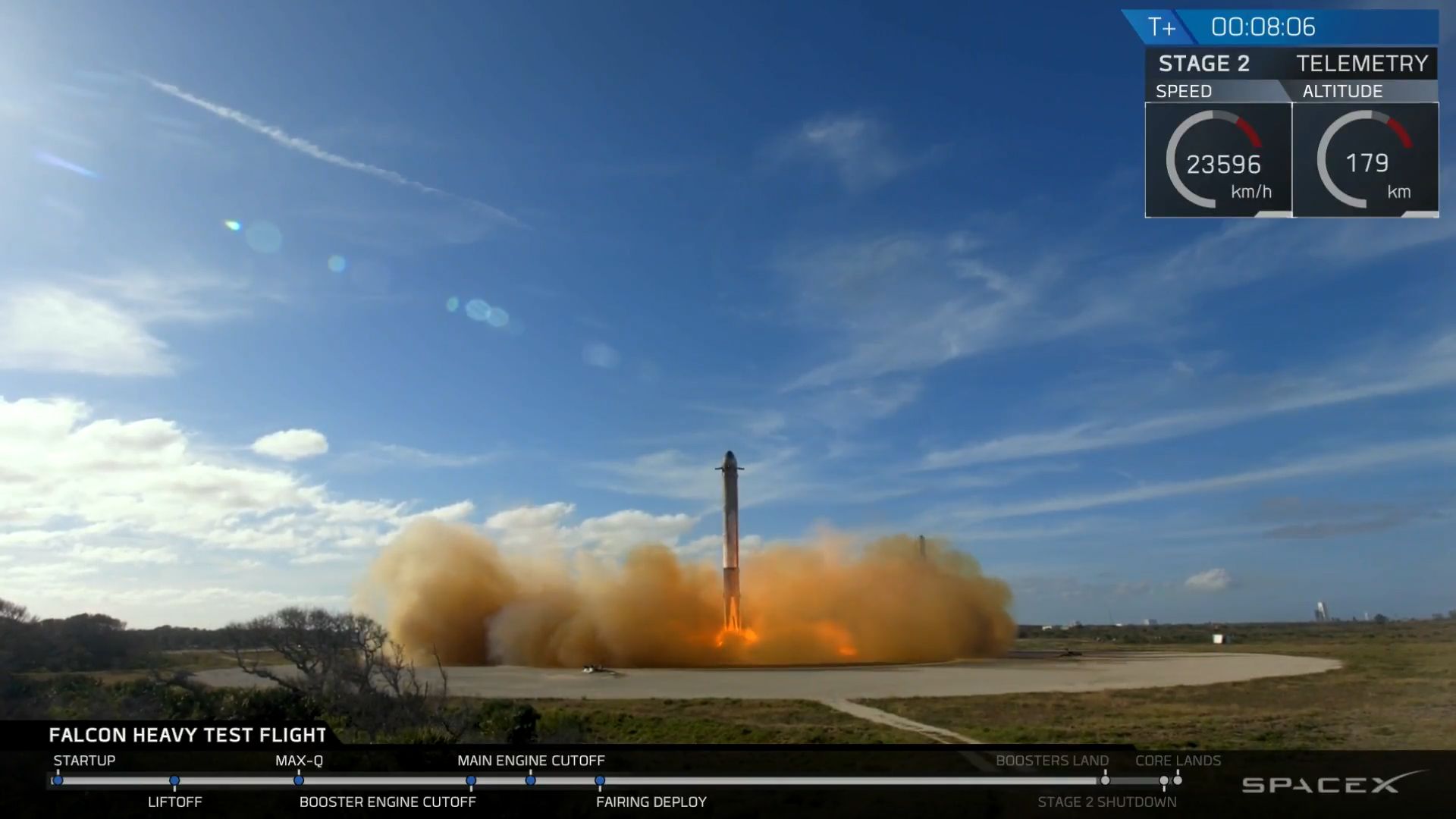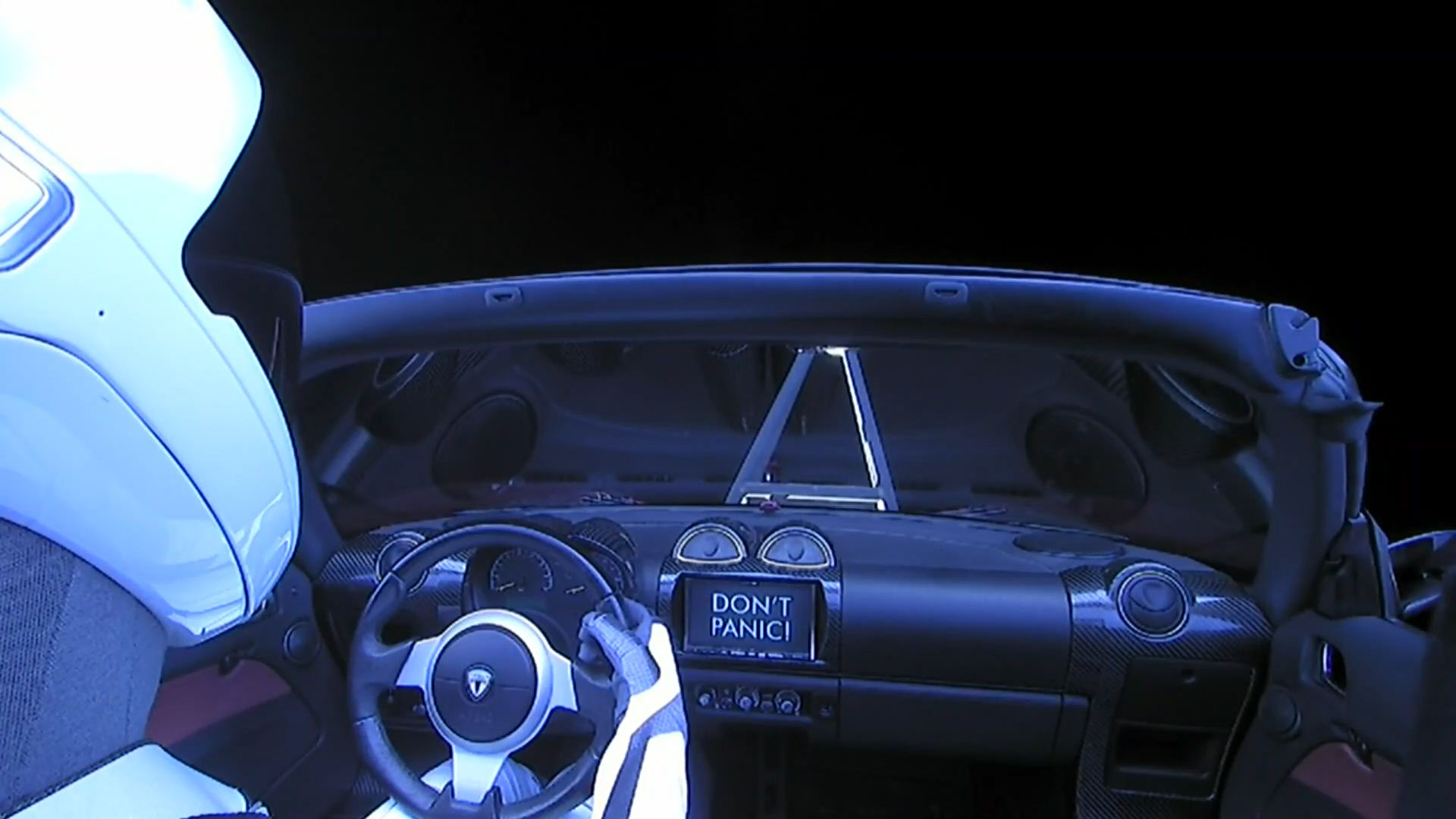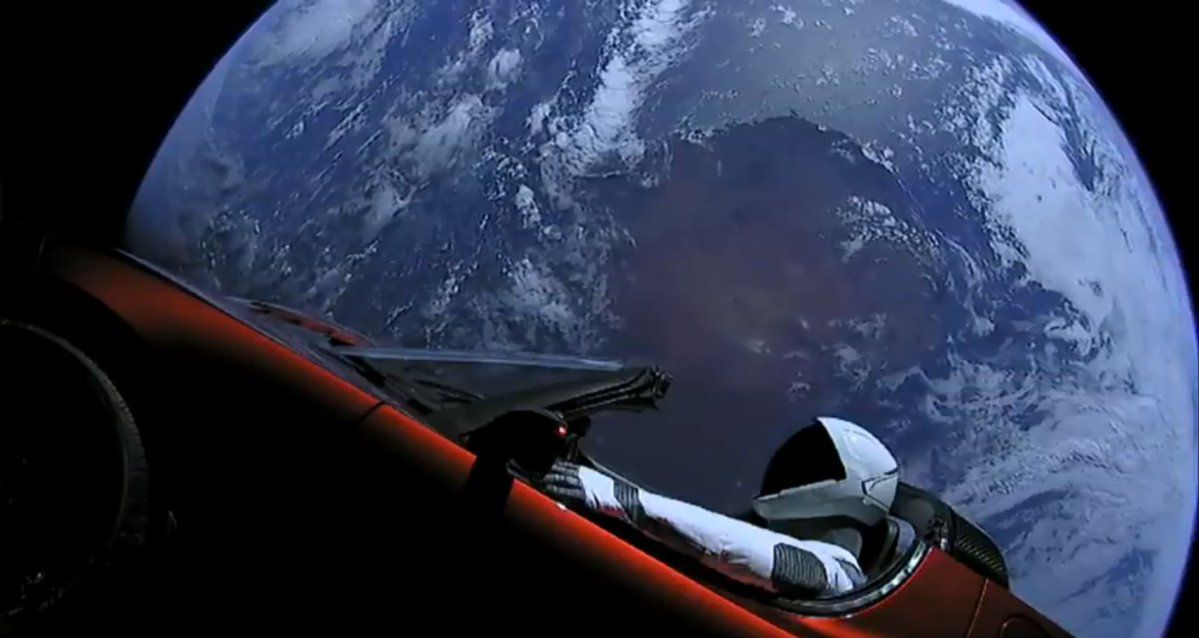Earlier this week, SpaceX lit the fuse on its biggest, baddest rocket to date. Dubbed the Falcon Heavy, the test flight was, more or less, a success. But the question remains – where do we go from here? Read on for a full rundown on what happened with the launch, as well as what to expect next.
Continue reading for the full story.
The Full Story
huge0
On Tuesday, February 6th, at 3:45 PM EST, the SpaceX Falcon Heavy rocket blasted off from Launch Pad 39A at the Kennedy Space Center in Florida, the same pad where the historic Apollo Moon missions took flight almost half a century prior. With all 27 of its individual Merlin engines lit, the Falcon Heavy produced over 5 million pounds of thrust, shooting into the sky in a brilliant display of fire and smoke.
Once the first stage was complete, the rocket's side boosters were jettisoned and redirected back towards Earth, where they landed simultaneously on the ground on parallel landing pads in Florida. Then the core booster was detached and redirected towards a “drone ship” landing pad located in the Atlantic Ocean.
Unfortunately, the core failed to ignite all three of its re-entry engines, and as a result, it hit the ocean at a rate of approximately 300 mph. It also missed the drone ship by about 300 feet, but the impact was great enough to take out two of the ship's engines, while also “ the deck with shrapnel,” according to Musk.
Regardless of the failed core landing, the Falcon Heavy's payload remained intact. After the core engine was disengaged, the upper stage engine was lit, propelling it into an even higher orbit around the Earth. Then SpaceX deployed the upper portion's fairing, revealing the Roadster and its Starman pilot and providing onlookers with a spectacular sight – one red drop-top sports car, plus humanoid figure in the driver's seat, both circling high above our Blue Dot as David Bowie's “Life On Mars?” twinkled in the background. On the car's infotainment screen was a plaque inscribed with “Don't Panic!”, a reference to Douglas Adams' famous novel “The Hitchhiker's Guide to the Galaxy.” No word on whether or not Starman brought a towel.
What followed was a six-hour “drift” intended to demonstrate a particularly technical orbital maneuver for the U.S. Air Force, during which SpaceX streamed a live feed of Starman drifting through the cosmos, with Earth and the infinite beyond providing the backdrop.
After enduring the intense radiation of the Val Allen belts, Starman and his Tesla got one final nudge out towards space. This last burn was intended to put the Roadster into orbit around the Sun for a slingshot out towards Mars, but according to recent posts to Musk's Twitter feed, it looks as though the payload will overshoot its target.
Rather than heading towards Mars as originally planned, it was initially believed that the burn would send Starman out as far as the Asteroid Belt, about 330 million miles from the Sun. However, the latest revised figures now put the orbit at roughly 160 million miles from the Sun, which is short of the asteroids, but still an overshoot on the original Mars target.
After breaking news of the overshoot on Twitter, Musk posted one final pic of Starman with Earth in the background.
It's not immediately obvious what will happen to Starman and his Tesla, but odds are it'll be obliterated by some kind of object (such as micrometeorites) as it travels through space at 25,000 mph. Cosmic radiation will also wreak havoc on the various leather and plastic bits in the car. If Starman survives the journey through space, the Sun's gravity will eventually loop him back towards the inner planets.
larger1
Despite the fact the core booster was obliterated and the payload overshot its target, this test flight is still considered a monumental success. The fact that the Falcon Heavy simply got off the ground opens up new opportunities for deep -space exploration, and the fact that the side boosters landed faultlessly demonstrates that the reusable rocket concept is now a very real thing.
And that's Read our full review on the 2008 Tesla Roadster. for the space industry. With the Falcon Heavy, companies looking far beyond Earth orbit now have options on the table. The launch signifies nothing less than a new era in commercial rocketry, with payload potentials that haven't been seen since the U.S. first sent astronauts to the Moon half a century ago. Not only that, but the reusable rocket concept promises to drive down costs significantly. Think around $10 million per launch, as opposed to upwards of $1 billion per launch.
“I'm very excited about this launch because I think this is really gonna show we can do giant rockets again,” Musk said in interview with Get in the Know - read up on the Latest Space X news or check out everything we’ve got on Elon Musk prior to the launch of Falcon Heavy. “Most space organizations, government or commercial, set their sights too low. They've really gotten, well, relatively small rockets, and Falcon Heavy is the first time that there's something arguably even in the super-heavy class, or somewhere between heavy and super-heavy. And showing that you can launch a giant rocket and have it be commercially viable, carry satellites, potentially carry people.”
The next steps for SpaceX are clear – continue development of its rocket technology, while simultaneously ramping up the launch schedule. First on the to-do list: figure out what happened with the core booster's landing burn. It's also expected that the Falcon 9 rocket will see incremental improvements across the board.
Furthermore, SpaceX has a newer, even larger candle in the works. It's called the Big Falcon Rocket, or BFR for short, and it's capable of putting a 330,000-pound payload into low-Earth orbit (the Falcon Heavy's max payload for low-Earth orbit is set at 140,700 pounds).
SpaceX hopes the BFR will replace both the Falcon 9 and Falcon Heavy by 2020, with the intention being its implementation for use in missions around the Earth, around the Moon, and eventually, all the way to Mars.
However, until the BFR is operational, the Falcon Heavy and the Falcon 9 will make up the entirety of SpaceX's future missions. The private company is aiming to launch as many as a dozen flights in 2018, including a Saudi Arabian communications satellite and a payload for the U.S. military, plus cargo deliveries to the International Space Station.
All cool stuff, no doubt about it. But even crazier are SpaceX's intentions to charter flights around the Moon for well-paying customers by the end of the year.
That's right folks – the age of space tourism is very nearly upon us.
So what's the end game? That much is clear – Elon Musk hopes to one day colonize Mars. However, getting there from here isn't exactly a straight-forward enterprise.
For starters, the launch vehicle to get us there needs a little work. Overshooting the target is fine when the payload is a mannequin in a Tesla. Once human lives come into play, those kinds of issues will obviously need to be resolved.
The BFR is the most obvious candidate for the job, but if it's not ready, Musk has stated that a Falcon Heavy topped with a Dragon spacecraft would work just as well.
However, once we're headed in the right direction, a new host of problems present themselves. The journey to Mars should take between six and eight months, which is a long time to be in space. Never mind the issue of food and water – the simple lack of gravity will cause muscles to atrophy and bones to deteriorate, while the extended isolation and tight quarters will wreak havoc on an astronaut's mind. Cosmic rays will also be an issue, causing cellular mutations and raising the risk of cancer.
Actually landing on Mars is an enormous undertaking in and of itself, but assuming everything falls into place, it's not yet clear how humans will be able to set-up a livable environment. Actually sustaining a colony on the Red Planet would require an insane amount of resources, all of which would need to be packed into the spacecraft with the actual astronauts in tow. One possibility is to send a supply ship ahead of the humans or after they arrive, but again, everything would have to go perfectly, or else it's game over for all involved.
All told, there's quite a few details that need to be ironed out before humanity can walk on Mars. That said, after watching Starman cruise around the Earth, arm propped casually on the window sill, it doesn't seem impossible. Humanity is now closer to inter-planetary travel than ever before.
Unfortunately, we've still gotta throw a bit of a wet blanket on the enthusiasm, as it bears mentioning that Musk's various ventures, from SpaceX to Tesla, have a habit of missing their deadlines. Granted, both companies are insanely ambitious with their timetables, but anyone expecting to book a flight to Olympus Mons next week probably shouldn't hold their breath.
More realistically, we hope the Falcon Heavy launch inspires other space companies to ramp up the R&D, a sentiment shared by Musk. When it comes to space travel, we say the more the merrier.
References
Tesla Roadster
Read our full review on the 2008 Tesla Roadster.
Get in the Know - read up on the Latest Space X news or check out everything we’ve got on Elon Musk



